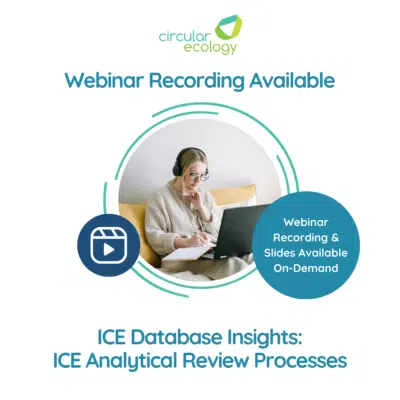BREEAM, one of the most widely recognised sustainability certification schemes, is aimed at measurement and improvement of environmental & sustainability performance in buildings & building construction projects. Through a series of categories, it looks to address the most impactful and influential factors of a building and its construction. “Materials” is one such category, and the Mat 01 assessment can be one of the first assessments undertaken in the process.
Mat 01 Life Cycle Assessment for BREEAM Building and Construction Projects

What is a Mat01 LCA?
The Mat 01 Life Cycle Assessment (LCA) is designed to assess and drive design decisions which reduce the environmental impacts of a construction project, either through the selection, quantity and composition of construction materials. It is focussed on a product’s efficiency, environmental impact, responsible sourcing and product durability over the life cycle of the selected materials and building itself.
The whole life approach considers impacts from a material’s manufacture, transport, installation, in-use stage and its end-of-life.
It’s possible to achieve a number of credits through the building’s construction timeline, to contribute to the project’s overall BREEAM score. The opportunity to achieve these credits can be lost if Mat01 is undertaken too late in the project. To achieve all of the credits available, Mat01 should be undertaken at concept design stage prior to submission of the planning application.
Ultimately, the Mat 01 assessment is intended to drive the integration of life cycle assessment outcomes into the design decision process, to achieve lower environmental impact buildings.
What are the key drivers for undertaking a Mat 01 Life Cycle Assessment?
- Achieving BREEAM credits and contributing to the overall rating of the project
- Contributing to progress against corporate sustainability requirements and targets
- Considering life cycle costs in tandem with environmental performance
- Marketing and PR benefits
What BREEAM credits are available through Mat01?
- 6 credits (core credits) – Superstructure:
- Undertaking superstructure LCA and options appraisal (3 additional options)
- Use of a BREEAM compliant LCA tool throughout project life cycle
- Comparison against the BREEAM LCA Benchmark
- 1 credit (additional credits) – Substructure and hard landscaping options appraisal during Concept Design:
- Undertaking substructure and hard landscaping LCA and options appraisal (6 significantly different options)
- Exemplary credits (up to 3 credits):
- Undertaking LCA and options appraisal (3 significantly different options) of core building services
- Verification by a suitably qualified third party
- Alignment of LCA and LCC (Life Cycle Cost)
Undertaking an LCA for Mat 01, is therefore a good opportunity to score multiple BREEAM credits.
When should Mat01 be undertaken?
Mat01 assessments should take place at RIBA Stage 2 Concept Design, then updated at RIBA Stage 4 Technical Design Stage. It is important to undertake the first LCA before the end of the RIBA Stage 2 (Concept Design) and also prior to the detailed planning application being submitted. The evidence also needs to be submitted to the BRE before the planning application is submitted. This is a firm deadline in the BREEAM requirements.
If this isn’t undertaken in time, the opportunity for most of the Mat 01 credits has been.
How long does a Mat01 take?
Timelines for Mat 01 LCAs vary, based on the availability of project information available, however Mat 01 assessments can often be completed within 4-8 weeks
How do you undertake a Mat01 LCA?
In order to obtain the Mat 01 LCA credits, it’s important to use an approved BRE IMPACT compliant tool, and to complete the first LCA and submit to the BRE at Concept Stage (RIBA Stage 2), before the detailed planning application is submitted.
At RIBA Stage 2 there isn’t detailed design information on the building, so typically an assessment would start with a site plan, BIM model, and any design information packs that are available at that time. These would be modelled in the BRE approved LCA tool, along with the embodied carbon reductions, and the results are submitted in the BRE Mat 01 templates, with an accompanying summary report.
The project should then update the same LCA at the end of Technical Design (RIBA Stage 4) and submit the updated paperwork to the BRE.
Please use the form below if you would like to reach out to us regarding these services:
Webinar Recap: ICE Insights: Methodological Challenges Behind the Scenes
Circular Ecology hosted the fourth webinar in the ICE Database Insights webinar mini series on [...]
Jun
DESNZ (Defra) 2025 GHG Emissions Factors Released
The UK Department for Energy Security and Net Zero (DESNZ) have just released the 2025 [...]
Jun
Webinar Recap: ICE Insights: Are All EPDs Created Equal?
On Thursday, 22nd May, Circular Ecology hosted the third instalment in the ICE Database Insights [...]
May
Webinar Recap: ICE Insights: ICE Analytical Review Processes
On Wednesday, April 30th, Circular Ecology hosted the second session of our ICE Database Insights [...]
Apr




